Monomad: A walk through the Soviet past
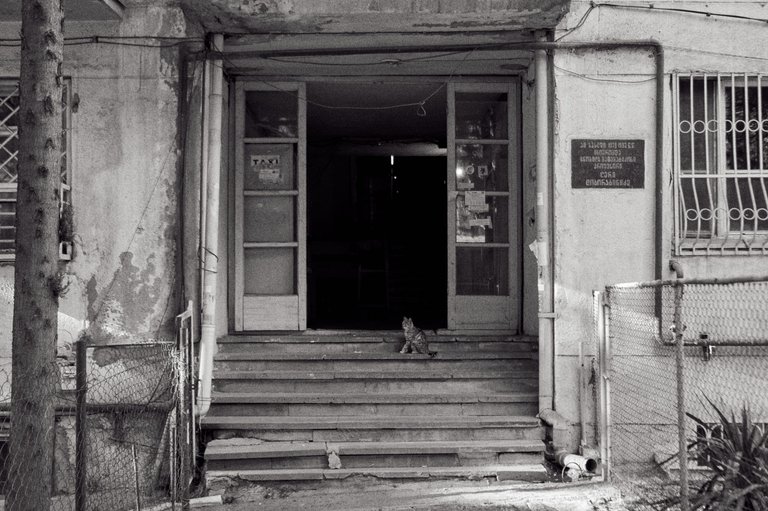
Today was a day of warmth again before the sun soon disappears and is replaced with more overcast days. I took advantage of that limited sun and got out to walk through an area I hadn't been through before in Tbilisi. I'm currently staying in one of the Soviet built districts named Saburtalo, and while the development here is increasing, it's also full of historic gems throughout. The best explorations being once you get off its grid system main roads and into the quiet little courtyards. I found a tiny park on the map that I had the intent of going to in efforts to fly my drone, but instead I didn't pull that thing out of the backpack once throughout the entire day. My curiosity and love for the Soviet oddities was too strong. I walked through old courtyard after old courtyard, catching that warmth of the sun in the process. Almost entirely avoiding the park. I used to spend entire days doing similar things, just walking through a district or area, with no set destination in mind, just seeing what I come across, and this was probably one of my favourite little explorations during my near year of being in Georgia. Having reached the park, the first thing to surprise me was a wall of apartment buildings all around. I looked on the map and it didn't show anything of major interest, but that only had me more curious as to what was on the other side of the huge hill I had just walked up.
This was an area that requires walking or driving up a hill with one main road through it, it was a tucked away little residential area sandwiched between the Saburtalo and Vake districts. And given its location and lack of existing space, it had managed to avoid the chaos of the modern day development rampage that has been going on within the districts. It felt like a huge step into the past, but what I found incredibly fascinating was how well kept much of this area was. Given it was still incredibly old at this point, and Soviet buildings are usually not known for being taken care of. Somewhat visible still from decades of neglect and weathering, but a significantly stronger sign of community was present compared to other areas. The interiors of the buildings were tidy, many still having their glass panels in the hallway. Not smashed up like all others. Some didn't have lighting still, dark and cold. My curiosity had me walk inside one of the huge wall buildings.
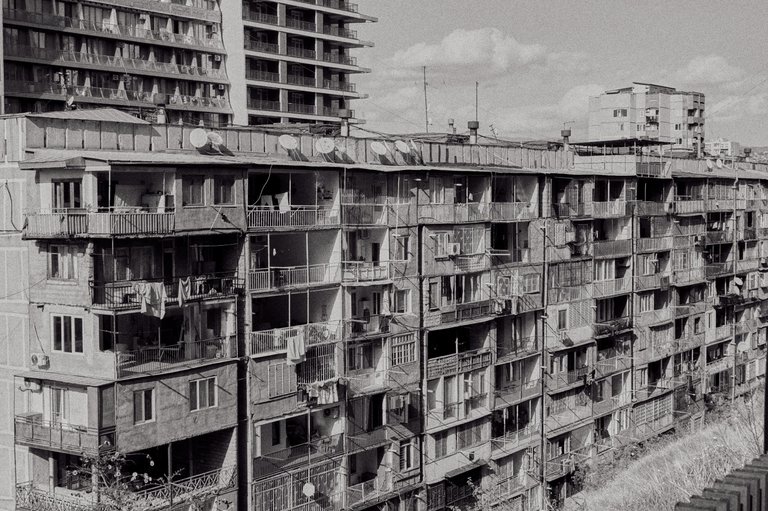
This sort of summarises the type of building I walked around. Though this was another one on the other side. the other had beautiful gardens and massive old trees that had been turning green. It was a warm up there but also a bit breezy, the only thing stopping you from really feeling the wind from up there being the buildings themselves the more you walk around. I saw a lot of old interiors, a lot of old hallways and doorways. Many of which still very much from the 70s era, but a little harder to capture given how dark inside they were. Right in the middle of all of this was a big old school that was still active. Under one Soviet high rise was a modern shop, which was an incredibly odd thing to see for me given how the door was like any other balcony door. And on their balcony they stored a lot of drinks. It was strange seeing a modern shop underneath such an old building, but I was a little jealous of how these people nearby had everything they could possibly need there. A beautiful park that overlooked the city. I walked behind the school down an old alleyway that was crumbling, up a stairway and found myself surrounded by even more buildings. Elderly women grouped up in the small parks outside them, enjoying the weather.
With the chaos of these two districts, riddled with noise and traffic, it was a surprise to me to see so many elderly people, but it was nice. A slower pace of life. I could see myself living in some of these buildings, though I wondered how many more years they had left (the buildings, that is). There was an earthquake earlier in the day here, a minor tremor, but when you walk around these buildings you see the cracks forming. The decay over decades. Their pillars slowly wasting away. These buildings are certainly built better than modern ones, but it seems as if they're a mere gust of wind away from collapsing at times. Their exteriors missing paint, all kinds of Frankenstein operations forming with people expanding upon balconies themselves, adding on brickwork or whatever they see fit with no awareness of the pressure it adds to the structure. Also slowly shaping new designs on these buildings over time, as they lose their initial designs. Of which all that really remains is the patterns on the concrete that can't be easily altered.
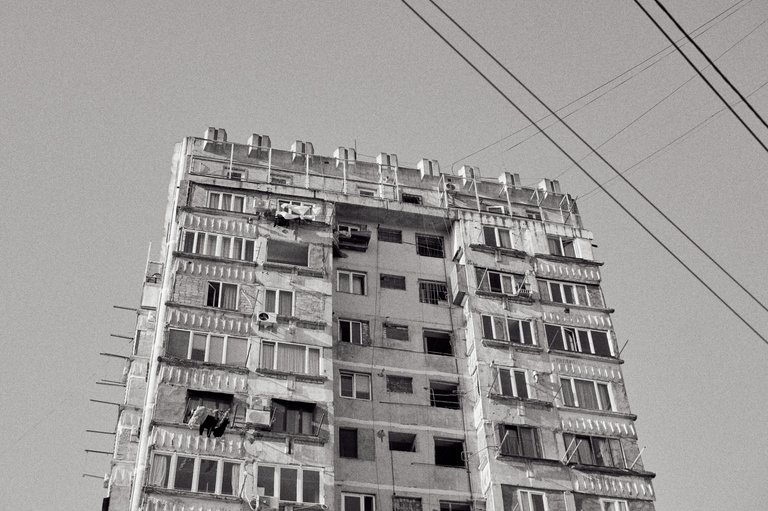
In some of these older areas you can still see the Russian influence. Signs in Russian that speak of the street names or the buildings. It's a bit more of a rarity these days as many have been changed to Georgian only. But even in some of the buildings you can find the odd advertisement from yesteryear that details something within the Russian language primarily. An ancient woman at one point, walking upward to somewhere more isolated, tried to speak to me. I had no idea what she was attempting to say or ask, though I did manage to understand her brief bit of Russian to me to which she asked if I understood Russian; I told her I didn't. As a lot of the older people do here, she shrugged it off immediately and went on her way without another word attempted. I questioned how old she as in my head, how long she had lived here, what she did in the past. This was such a deeply old area that I couldn't help but have that curiosity over the lives that do and once lived here. And with so many little signs of its former glory around, I almost didn't want to start heading back down to the newer locations. Pomegranate trees outside apartments. Old 70s cupboards repurposed for dog and cat shelters.
In some instances I wish I had a wider focal length lens for capturing some of the lower parts of the buildings, each of them having their own designs, some more decorated than others. A little bit of modernisation in the parks nearby. Though always a little bit of that homemade feeling that's found around here as people build their own tables for board games.
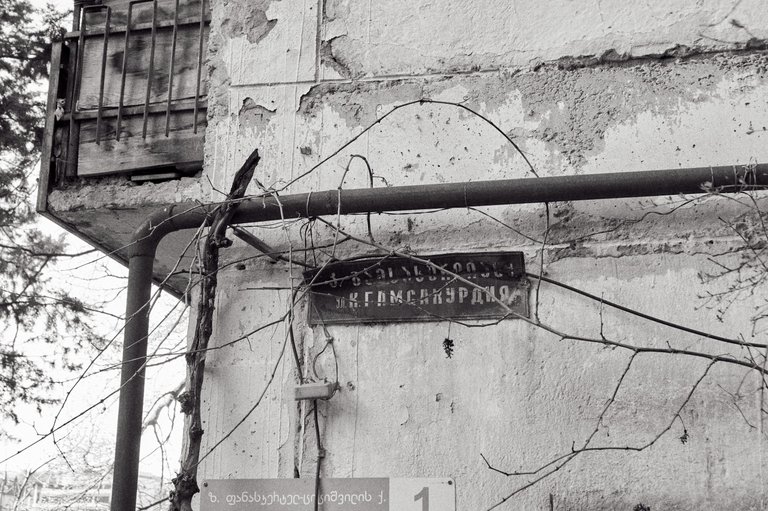
Little stands were also found, completely boarded up. I think they would've been small stands that would've once sold little things like water or tobacco products back in the day. Now with no purpose. Oddly enough this one was found right outside of a school. I tried and wanted to photograph it without anyone in the way, but out of nowhere a lot of cars and people began to appear, though one woman walked by that seemed almost fitting for the image and era. Something I noticed within this small area: the fashion style was certainly of its time. I quite liked that, it felt unique.
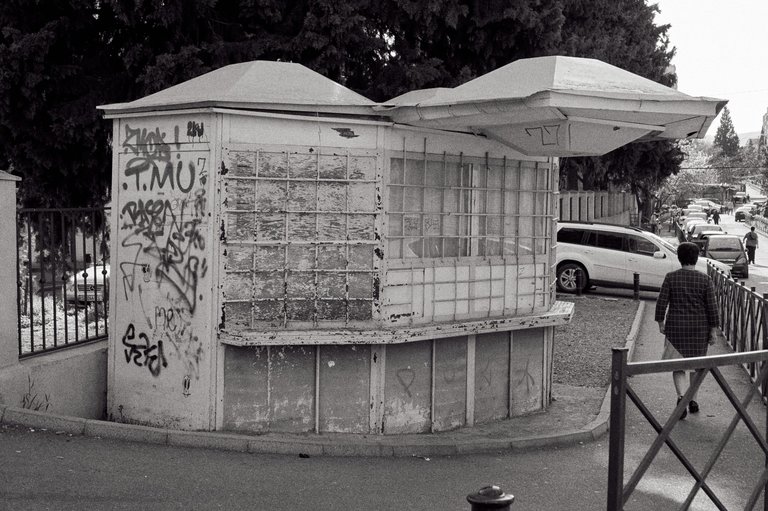
It made me really nostalgic for the days in which I'd endlessly explore such areas. I had a lot of fun here, and it's always great fun to roam through an area and think of how it was once, to discover little aspects of the past within them. Finding stories from previous decades that are effectively ignored or left to rot on the sides of buildings or by their entrances. Curious eyes like mine consider it digging for gold.
You can check out this post and your own profile on the map. Be part of the Worldmappin Community and join our Discord Channel to get in touch with other travelers, ask questions or just be updated on our latest features.
Undoubtedly, Soviet architecture had its particularity at the time, it was even a worldwide influence because even in Latin countries you can still see structures with many influences from the Soviet era.
Growing up in England, I saw a lot of what we would refer to as brutalism in some of the architecture, mostly around the 60s - 80s. Which is a similar period to that of the USSR's development. But it's still very different in many ways, and I really enjoy stumbling across those more unique buildings. I stumbled across an Instagram page yesterday that posts photographs of the various SSRs and seeing such areas I've been to during their heights really showed how beautiful it all once was.
These days the general mentality of anything Soviet being bleak makes sense because the neglect over many decades is present. Those buildings crumbling, mosaics fading, paintwork peeling off. Also the lack of care in the surroundings as the ecological concept died off for the longest time and only recently became more of an issue again. Tbilisi is pretty good in that sense still though, it is a very green city. But in Yerevan for example, in some districts it's just total decay, nothing green to pull some life out.
I think I love walking around these areas and capturing them because I can imagine how they would've once been. In some ways I do feel the sadness as I realise that the greatness and pride in it all is now gone. I posted about a huge cascade here in Tbilisi the other day, I thought it was never finished. But that Instagram page had an image (must've been the late 70s) of the cascade fully developed with the fountains all running. So green and with people walking around it. Things like that can be tough to see. It does often feel like you're just walking around the relics of a bygone era.